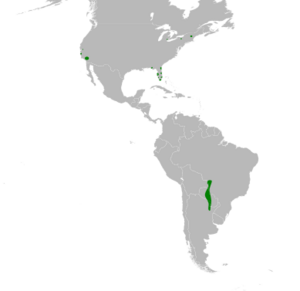Nanday parakeet facts for kids
Quick facts for kids Nanday parakeet |
|
|---|---|
 |
|
| In Strasbourg, Parc de l'Orangerie | |
| Conservation status | |
| Scientific classification | |
| Genus: |
Aratinga
|
| Species: |
nenday
|
 |
|
| Synonyms | |
|
Nandayus nenday (Vieillot 1823) |
|
The nanday parakeet (Aratinga nenday), also known as the black-hooded parakeet or nanday conure, is a medium-sized green parrot. It is native to South America. These birds are known for their black faces, which look like a hood!
Contents
About Its Name and Family
For a long time, the nanday parakeet was thought to be the only bird in its own special group, called Nandayus. But scientists who study birds often look closely at their DNA. This helps them understand how different species are related.
New studies showed that the nanday parakeet actually belongs with other parrots in the Aratinga group. This group includes popular birds like the sun conure and the jenday conure. Scientists believe the nanday parakeet and the sun conure separated into different species about 0.5 to 1.3 million years ago. Sometimes, nanday parakeets can even have babies with sun conures or jenday conures.
Scientists have also found old bones of a parrot related to the nanday parakeet. These bones were found in Argentina and are from a very long time ago.
What Does It Look Like?
The nanday parakeet is about 27 to 30 centimeters (11 to 12 inches) long. It weighs around 140 grams (5 ounces). Most of its body is green.
Its most special feature is its black face and beak, which gives it the name "black-hooded." The feathers on its wings are black at the ends. Its long tail has blue tips. The upper part of its chest is bluish-green, and the lower part is a lighter green. The feathers on its upper legs are red.
Where Do They Live?
Nanday parakeets are originally from parts of South America. This includes southeast Bolivia, southwest Brazil, central Paraguay, and northern Argentina. They are often found in a wetland area called the Pantanal.
Sometimes, pet birds escape or are set free. Because of this, nanday parakeets have started living in new places. You can now find groups of them living on their own in places like Tenerife (an island off Spain) and several areas in the United States. These include Los Angeles, California, San Antonio, Texas, and many parts of Florida.
Behavior
What Do They Eat?
These parakeets eat many different things. Their diet includes seeds, fruit, palm nuts, berryies, flowers, and buds. If they live near people, they might also visit bird feeders.
In the wild, they like to live in scrub forests and open areas near towns. They are often seen in open savannahs and farmlands in South America. In some places, farmers see them as pests because they eat crops.
How Do They Reproduce?
Nanday parakeets usually make their nests in holes they find in trees. The female bird typically lays three or four eggs. After the young birds grow up, all the parakeets gather together. They form large groups to sleep in until it's time to breed again the next year.
Nanday Parakeets as Pets
Some people keep nanday parakeets as pets. They are loud and full of energy. These birds need a lot of attention and things to do to stay happy and healthy. They also need plenty of time outside their cage.
Because they have strong beaks, they might not be the best pets for very young children. However, nanday parakeets can learn to talk and even do tricks! The World Parrot Trust suggests that if you keep a nanday parakeet, its cage should be at least 2 to 3 meters (6.5 to 10 feet) long. The longest a nanday parakeet has been known to live is about 18.7 years. Some reports even say they can live over 30 years in captivity.
Images for kids





